February 28, 2016
by Carole Zangari -

Here are some AAC posts you may have missed. Monday – PrAACtically Pinteresting with Lauren Enders: Apps for Implementation Tuesday – From Conversation to Skill-building Thursday – AAC Assessment Corner by Vicki Clarke: Thinking Inside the Box
Filed under: PrAACtical Thinking
February 25, 2016
by Carole Zangari -
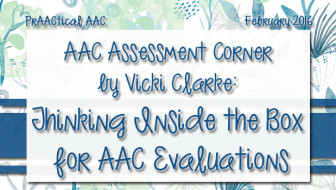
AAC assessment is a challenge in almost every service delivery setting, and many of you have reached out to us to ask for advice on how to strengthen your assessment practices. Luckily, Vicki Clarke, an AAC Chick who has a great deal of experience assessing learners in clinical and educational settings, has tips and resources to share. In this continuation of the AAC Assessment Corner series, Vicki talks about a key feature in any AAC system: vocabulary organization. ::::::::::::::::::::::::::::::::::::::::::::::::::::::::::::::::::::::::::::::::::::::::::::: Thinking Inside the Box for AAC Evaluations: What Type of Vocabulary Organization is Right For Your AAC User? Professionals often spend a great deal of time concerning themselves with which box they should get their AAC user. Should I pick a Prentke Romich or a Tobii Dynavox? But what about the iPad? And what about the money? Should I pick a CheapTalk or a GoTalk instead? Here’s the good news: The box is not the... [Read More...]
Filed under: Featured Posts, PrAACtical Thinking
Tagged With: assessment, feature match, language organization
February 23, 2016
by Carole Zangari -

AAC learners need a lot of support as they build the skills needed to have rich and effective conversations. Often, their role in the conversation is punctuated with partners’ reliance on context, prior knowledge, and questions to make sense of the message. What do we do when the learner gives us partial information or uses language skills below his/her capability? Do we accept the limited language so that we get to the bottom of the message our learner is trying to express? Or do we use it as an opportunity to shape improved language skills? One approach to making this decision is to start with a question. “What is the top priority for this interaction?” Making a decision about the most important goal of the conversation is a critical step in determining how to respond. In some cases, the time is right to use the opportunity to improve skills in... [Read More...]
Filed under: PrAACtical Thinking
Tagged With: intervention
February 22, 2016
by Carole Zangari -
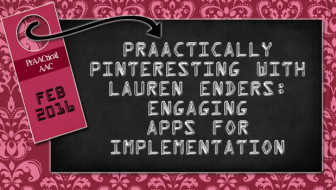
Today, we welcome back an old friend, Lauren Enders. Many of you are already familiar with Lauren through the posts she has shared on AAC in the IEP, encouraging AAC implementation, and writing AAC goals, and also the wonderful work she does in curating resources on Pinterest. We’re thrilled that she will be joining us each month to highlight a different Pinterest board that has AAC-related content. Lauren identifies interesting and helpful resources and adds relevant commentaries to all of the items she includes. In this first post, she shares a collection of resources on apps that can be used to engage AAC learners in therapy, instruction, play, and leisure time. ::::::::::::::::::::::::::::::::::::::::::::::::::::::::::::::::::::: For the past few years, I have been building a Pinterest site with the goal of providing visual, categorized, and easily accessible resources that relate to AAC as well as Assistive Technology, Speech and Language Therapy, Special Education, iPads,... [Read More...]
Filed under: Featured Posts, PrAACtical Thinking
Tagged With: digital curation, resources
February 21, 2016
by Carole Zangari -

Hope you had a week of AAC fun and inspiration. Monday – PrAACtically Reading with Karen Natoci: Are You My Mother? Tuesday – Efficiency or Precision: Striking a Balance for AAC Learners Thursday – Video of the Week: Aided Language Input with Gail Van Tatenhove
Filed under: PrAACtical Thinking
February 16, 2016
by Carole Zangari -
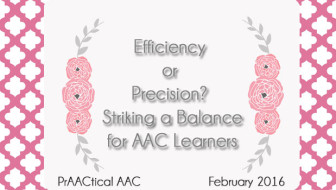
Elliott has been using some form of high tech AAC since he was in kindergarten and can express wants/needs easily. Though his language is simplistic compared to his 5th grade peers, he is able to use his SGD to give opinions, explain them, ask questions, engage in small talk, and tell short narratives. His SLP has targeted skills in inferencing, use of prefixes (‘un’ and ‘re’), verbal reasoning, Tier 2 vocabulary, and embedded clauses to help Elliott acquire the language skills that will allow him to be more successful in his academic work. She is keenly aware that, as he transitions to middle school, the academic and social demands on him will increase significantly. Although Elliott can spontaneously produce 9-12 word sentences, he usually communicates in short, simple utterances. In a recent interaction he used a single word, ‘good,’ to describe a video, and a short sentence (‘I was mad’)... [Read More...]
Filed under: Featured Posts, PrAACtical Thinking
Tagged With: interaction, language intervention
February 15, 2016
by Carole Zangari -
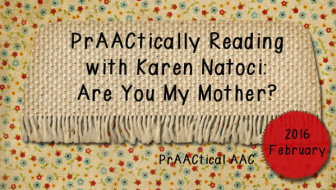
We get many requests to do more posts on providing AAC supports to children who use alternative access. Karen Natoci must have read my mind when she wrote this month’s PrAACtically Reading post because she gave us lots of ideas for shared reading with a child who is learning to use eye gaze for communication. The book that she chose is a P.D. Eastman classic that many of us remember from our own childhoods. Happy reading! Shared Reading Using Eye Gaze Book: Are You My Mother? by P.D. Eastman CORE Words to practice using: you, want, where, look, more, no, go, like, oh no! mine FRINGE Words to practice using: Animal names, mother, snort!! I am happy to share this lesson plan to describe the integration of early eye gaze and switch use to foster engagement while reading the delightful book, Are you My Mother? (authored by P.D. Eastman). Today, I chose... [Read More...]
Filed under: Featured Posts, PrAACtical Thinking
Tagged With: eye gaze, reading
February 14, 2016
by Carole Zangari -

What’s been happening in your prAACtical life? Monday – PrAACtical Thoughts on Challenging Behavior and Emotional Regulation from the 2016 CARD Conference Tuesday – Teach Me Tuesday: Scene Speak Thursday – Video fothe Week: Who Can Pay for AAC Devices for Public School Students by Lew Golinker
Filed under: PrAACtical Thinking
February 9, 2016
by Carole Zangari -

Interested in learning more about Scene Speak by Good Karma Applications? Here are some useful links. User Guide Creating New Scenes Video Creating a New Hotspot Video Editing a Hotspot Video Using the Settings Menu Video Creating a Book Video Where to Go for Help: Knowledge Base and Contact form
Filed under: PrAACtical Thinking
Tagged With: Teach Me Tuesday
February 8, 2016
by Carole Zangari -
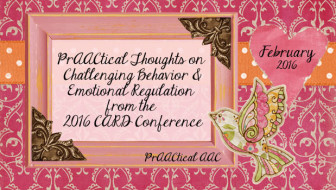
Last month, I had an opportunity to hear Dr. Barry Prizant, Director of Childhood Communication Services and Adjunct Professor at Brown University, at the 2016 Center for Autism and Related Disabilities Conference. Many of you know Dr. Prizant as co-author of SCERTS, the Social Communication Emotional Regulation Transactional Supports Program, and his recent book, Uniquely Human, discussed in this video. At this conference, he spoke on ‘An Emotional Regulation Approach to Preventing Problem Behavior.’ Here are some points of interest from his presentation. Dr. Prizant suggested that when someone is dysregulated, the first thing we should think about is biological factors that may be causing or exacerbating the problem. Why? Because unless we address the root of the problem, chances are slim that any behavioral, communicative, or psychological strategies will be effective in the long run. In some cases, there is a rather straightforward solution, such as teaching our client... [Read More...]
Filed under: PrAACtical Thinking
Tagged With: Challenging Behavior, emotional regulation









